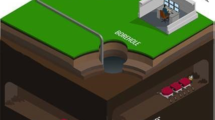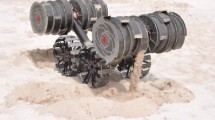Abstract
ROBOMINERS was a project funded under the European Union’s Research and Innovation programme Horizon 2020 (grant agreement n°820971) and started in June 2019 with the primary objective of facilitating the extraction of mineral resources, including strategically important metals crucial for the ongoing energy transition, from domestic sources within the European Union. To achieve this goal, the ROBOMINERS consortium—including 14 partners from 11 European countries, has developed a bio-inspired robot specifically designed for mining deposits that are challenging to access or relatively small in scale. The prototype was tested and demonstrated in July, August and October 2023.
Zusammenfassung
ROBOMINERS war ein Projekt, das im Rahmen des Forschungs- und Innovationsprogramms Horizont 2020 der Europäischen Union (Grant agreement Nr. 820971) finanziert wird und im Juni 2019 mit dem vorrangigen Ziel gestartet wurde, die Gewinnung von mineralischen Ressourcen, einschließlich strategisch wichtiger Metalle, die für die laufende Energiewende entscheidend sind, aus heimischen Quellen innerhalb der Europäischen Union zu erleichtern. Um dieses Ziel zu erreichen, hat das ROBOMINERS-Konsortium, dem 14 Partner aus 11 europäischen Ländern angehören, einen bio-inspirierten Roboter entwickelt, der speziell für schwer zugängliche oder relativ kleine Lagerstätten konzipiert ist. Der Prototyp wurde im Juli, August und Oktober getestet und vorgestellt.
Similar content being viewed by others
After four years of extensive work, the ROBOMINERS consortium tested their prototype (RM1) of a small-scale mining robot in Rakvere (Estonia). The second field test focused on the perception and analysis equipment of the prototype and was conducted in Mežica (Slovenia).
The RM1 prototype comprises multiple functionalities, ranging from navigation, perception, excavation, and ore transport to in-line analysis. In order to excavate ore continuously, a small-scale part-face cutter head was chosen as a suitable production tool. This cutter head was developed together with Sandvik Mining and Construction in Zeltweg, using their know-how in mechanical cutting tools and acting as a long-standing market leader in the mining machinery industry. Subsequently, this cutter head was tested extensively in the laboratory of the Conveying Technology and Design Methods (Chair of Mining Engineering and Mineral Economics) in Leoben. The tests provided detailed results of the applicability of this small-scale cutter head in different rock conditions.
The final demonstration of the RM1 prototype took place in an open-pit mine (Fig. 1) during July and August 2023 and marked a significant milestone in the project’s mission of enhancing European access to mineral raw materials and reducing import dependency. There were three basic requirements for the test sites:
-
The strength (UCS) of the host rock should be in the range of 20–40 MPa in order to meet the target KPI defined during the first stages of ROBOMINERS for the production tool.
-
Rock self-sustainability: No supporting structures are foreseen. Therefore, the host rock should be strong enough to avoid collapsing.
-
The site should provide “interesting” mineralization structures and elements that allow demonstrating geophysical sensors and mineralogy sensors.
In the field trials that took place, the ROBOMINERS project subjected its full-scale prototype RM1 to real-world conditions, specifically targeting rock properties. The testing phase concentrated on confirming the efficacy of both the production tool module and locomotion. Control algorithms for both the production tool module and locomotion functions were honed during testing to improve their responsiveness in real-life non-ideal conditions. Demonstrations were conducted with the robot partially submerged, showcasing its capabilities:
-
Locomotion strategies
-
Production tool module operation and rock cutting
-
Cuttings transportation
-
Sensor functions
On site, these activities were accompanied by several members of the project consortium, including Michael Berner and Nikolaus A. Sifferlinger. On August 2nd 2023, the prototype was presented on site to a selected group of people including mining academics and professionals (Fig. 2).
Further tests were conducted in an underground mine in Mežica (Slovenia). The RM1 demonstration site featured the Podzemlje Pece touristic mine, where sensor testing took place in both the underground sections of the tourist mine and the underground mine located at the TAB Žerjav industrial site, operated by GM Žerjav. During the tests, the following sensing technologies were tested and validated in a relevant environment: Standoff Laser Induced Breakdown Spectroscopy (ST-LIBS), Electrical Resistivity Tomography and Induced polarization (ERT and IP), Hyperspectral and UV fluorescence. The Žerjav mineralization exhibits disseminated sphalerite (ZnS) with traces of amorphous galena (PbS) found in dolomite and limestone host rocks. In contrast, Mežica mineralization is predominantly characterized by galena veins within a dolomitic host rock. This mineralization serves as an illustrative scenario for the potential application of the ROBOMINERS platform.
The ROBOMINERS project ended in November 2023 and eventually, a follow-up project is planned in the near future to continue this successful story.
Funding
This project has received funding from the European Union’s Horizon 2020 research and innovation programme under grant agreement No. 820971.
Funding
Open access funding provided by Montanuniversität Leoben.
Author information
Authors and Affiliations
Corresponding author
Additional information
Publisher’s Note
Springer Nature remains neutral with regard to jurisdictional claims in published maps and institutional affiliations.
Rights and permissions
Open Access This article is licensed under a Creative Commons Attribution 4.0 International License, which permits use, sharing, adaptation, distribution and reproduction in any medium or format, as long as you give appropriate credit to the original author(s) and the source, provide a link to the Creative Commons licence, and indicate if changes were made. The images or other third party material in this article are included in the article’s Creative Commons licence, unless indicated otherwise in a credit line to the material. If material is not included in the article’s Creative Commons licence and your intended use is not permitted by statutory regulation or exceeds the permitted use, you will need to obtain permission directly from the copyright holder. To view a copy of this licence, visit http://creativecommons.org/licenses/by/4.0/.
About this article
Cite this article
Berner, M., Sifferlinger, N.A. H2020-ROBOMINERS Prototype Field Test. Berg Huettenmaenn Monatsh 169, 197–198 (2024). https://doi.org/10.1007/s00501-024-01445-9
Received:
Accepted:
Published:
Issue Date:
DOI: https://doi.org/10.1007/s00501-024-01445-9






